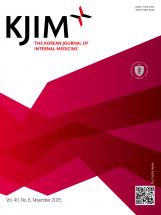|
Rheumatology / Original Article
Association of peripheral leukocyte telomere length with patients with rheumatoid arthritis with a focus on interstitial lung disease
Young Bin Joo, So-Young Bang, Su Jin Hong, Youkyung Lee, Dongjik Shin, Sang-Cheol Bae, Hye-Soon Lee
Korean J Intern Med. 2025;40(4):676-686. Published online April 1, 2025
Background/Aims: This study investigated whether telomere length (TL) in rheumatoid arthritis (RA) patients is shorter than in controls, whether TL in RA patients with interstitial lung disease (RA-ILD) differs from that in those without ILD (RA-nonILD), and whether TL varies according to RA-ILD pat..
|
|
|
Pulmonology / Original Article
Impact of tracheostomy on clinical outcomes in ventilated patients with severe pneumonia: a propensity-matched cohort study
Hayoung Seong, Hyojin Jang, Wanho Yoo, Saerom Kim, Soo Han Kim, Kwangha Lee
Korean J Intern Med. 2025;40(2):286-298. Published online March 1, 2025
Background/Aims: Tracheostomy is a crucial intervention for severe pneumonia patients requiring prolonged mechanical ventilation (MV). However, debate persists regarding the influence of tracheostomy timing and performance on long-term survival outcomes. This study utilized propensity score matching..
|
|
|
Pulmonology / Original Article
Risk factors for progressing to critical illness in patients with hospital-acquired COVID-19
Kyung-Eui Lee, Jinwoo Lee, Sang-Min Lee, Hong Yeul Lee
Korean J Intern Med. 2024;39(3):477-487. Published online April 18, 2024
Background/Aims: Risk factors for progression to critical illness in hospital-acquired coronavirus disease 2019 (COVID-19) remain unknown. Here, we assessed the incidence and risk factors for progression to critical illness and determined their effects on clinical outcomes in patients with hospital-..
|
|
|
Rheumatology / Original Article
Nailfold capillaroscopy findings of interstitial pneumonia with autoimmune features
Sang-Heon Lee, Hong Ki Min, Se-Hee Kim, Young Whan Kim, Kwang Ha Yoo, Hee Joung Kim, In Ae Kim, Hae-Rim Kim
Korean J Intern Med. 2023;38(6):903-911. Published online July 25, 2023
Background/Aims: We evaluated nailfold capillaroscopy (NFC) of interstitial pneumonia with autoimmune features (IPAF) and compared it with that of patients with connective tissue disease-interstitial lung disease (CTD-ILD) and idiopathic interstitial pneumonia (IIP).
Methods: Patients with newly di..
|
|
|
Pulmonology / Original Article
The serotype-specific prevalence of pneumococci in hospitalized pneumonia patients with COPD: a prospective, multi-center, cohort study
Jae Yeol Kim, Jae-Woo Jung, Min-Jong Kang, Deog Kyeom Kim, Hayoung Choi, Young-Jae Cho, Seung Hun Jang, Chang-Hoon Lee, Yeon Mok Oh, Ji Sook Park
Korean J Intern Med. 2023;38(5):714-724. Published online August 17, 2023
Background/Aims: The overall incidence of pneumococcal pneumonia is declining. However, the change in the pathogenic distribution of community-acquired pneumonia (CAP) in chronic obstructive pulmonary disease (COPD) patients and the serotype specificity of Streptococcus pneumoniae have not be..
|
|
|
Pulmonology / Original Article
The impact of antimicrobial de-escalation therapy in culture-negative pneumonia: a systematic review and meta-analysis
Jae-Uk Song, Jonghoo Lee
Korean J Intern Med. 2023;38(5):704-713. Published online August 17, 2023
Background/Aims: Antimicrobial de-escalation (ADE) remains a challenging strategy in the treatment of pneumonia. We investigated the outcomes of ADE as measured by mortality and duration of the use of antibiotics in patients with culture- negative pneumonia.
Methods: We performed a systematic revie..
|
|
|
Pulmonology / Original Article
Microbiologic pattern and clinical outcome of non-ICU-acquired pneumonia: Korean HAP registry analysis
[corrected-article]
Jin Ho Jang, Hye Ju Yeo, Taehwa Kim, Woo Hyun Cho, Kyung Hoon Min, Sang-Bum Hong, Ae-Rin Baek, Hyun-Kyung Lee, Changhwan Kim, Youjin Chang, Hye Kyeong Park, Jee Youn Oh, Heung Bum Lee, Soohyun Bae, Jae Young Moon, Kwang Ha Yoo, Hyun-Il Gil, Kyeongman Jeon; on behalf of the Korean HAP/VAP Study Group
Korean J Intern Med. 2022;37(4):800-810. Published online June 28, 2022
Background/Aims: Most studies on hospital-acquired pneumonia (HAP) have been conducted in intensive care unit (ICU) settings. This study aimed to investigate the microbiological and clinical characteristics of non-ICU-acquired pneumonia (NIAP) and to identify the factors affecting clinical outcomes ..
|
|
|
Pulmonology / Original Article
Diagnostic index for acute eosinophilic pneumonia without bronchoscopy in military smokers
Sunmin Park, Deokjae Han, Ji Eun Lee, Duck Hyun Ryu, Hyung-Jun Kim
Korean J Intern Med. 2022;37(2):377-386. Published online December 16, 2021
Background/Aims: Acute eosinophilic pneumonia (AEP) is common among military smokers; however, bronchoscopy is required for the diagnosis. We aimed to derive and validate a scoring system to diagnose AEP without bronchoscopy.
Methods: We conducted a retrospective study including patients diagnosed ..
|
|
|
Review
Aerosolized antibiotics in the treatment of hospital-acquired pneumonia/ventilator-associated pneumonia
Yun Jung Jung, Eun Jin Kim, Young Hwa Choi
Korean J Intern Med. 2022;37(1):1-12. Published online October 21, 2021
Aerosolized antibiotics are being increasingly used to treat respiratory infections, especially those caused by drug-resistant pathogens. Their use in the treatment of hospital-acquired pneumonia and ventilator-associated pneumonia in critically ill patients is especially significant. They are also ..
|
|
|
Pulmonology / Original Article
Pleuroparenchymal fibroelastosis in Korean patients: clinico-radiologic-pathologic features and 2-year follow-up
Jae Ha Lee, Eun Jin Chae, Joon Seon Song, Miae Kim, Jin Woo Song
Korean J Intern Med. 2021;36(Suppl 1):S132-S141. Published online February 24, 2020
Background/Aims: Pleuroparenchymal fibroelastosis (PPFE) is a type of rare idiopathic interstitial pneumonia that is characterized by predominantly upper lobe involvement with pleural fibrosis and subjacent parenchymal fibrosis. This study aimed to determine the clinico-radiologic-pathologic feature..
|
|
|
Cardiology / Original Article
Different therapeutic associations of renin-angiotensin system inhibitors with coronavirus disease 2019 compared with usual pneumonia
Hae-Young Lee, Juhee Ahn, Juhong Park, Chang Kyung Kang, Sung-Ho Won, Dong Wook Kim, Jong-Heon Park, Ki-Hyun Chung, Joon-Sung Joh, JI Hwan Bang, Cheong Hee Kang, Myoung-don Oh, Wook Bum Pyun; The Korean Society of Hypertension; The National Committee for Clinical Management of Emerging Infectious Diseases
Korean J Intern Med. 2021;36(3):617-628. Published online April 16, 2021
Background/Aims: Although it is near concluded that renin-angiotensin system inhibitors do not have a harmful effect on coronavirus disease 2019 (COVID-19), there is no report about whether angiotensin receptor blockers (ARBs) and angiotensin-converting enzyme inhibitors (ACEIs) offer any protective..
|
|
|
Original Article / Brief Communication
Clinical implication and risk factor of pneumonia development in mild coronavirus disease 2019 patients
Hyun Woo Lee, Seo-Young Yoon, Jung-Kyu Lee, Tae Yeon Park, Deog Kyeom Kim, Hee Soon Chung, Eun Young Heo
Korean J Intern Med. 2021;36(1):1-10. Published online December 1, 2020
Background/Aims: Although a majority of coronavirus disease 2019 (COVID-19) cases were characterized as mild, data assessing the development of pneumonia in mild COVID-19 patients are limited. We aimed to examine the effect of pneumonia development on the clinical course of mild COVID-19 in hospital..
|
|
|
Original Article / Brief Communication
Lung ultrasound for early diagnosis and severity assessment of pneumonia in patients with coronavirus disease 2019
[corrected-article]
Young-Jae Cho, Kyoung-Ho Song, Yunghee Lee, Joo Heung Yoon, Ji Young Park, Jongtak Jung, Sung Yoon Lim, Hyunju Lee, Ho Il Yoon, Kyoung Un Park, Hong Bin Kim, Eu Suk Kim
Korean J Intern Med. 2020;35(4):771-781. Published online July 1, 2020
Background/Aims: Current evidence supports lung ultrasound as a point-ofcare alternative diagnostic tool for various respiratory diseases. We sought to determine the utility of lung ultrasound for early detection of pneumonia and for assessment of respiratory failure among patients with coronavirus ..
|
|
|
Pulmonology / Original Article
Performance of pneumococcal urinary antigen test in patients with community-onset pneumonia: a propensity score-matching study
Jonghoo Lee, Jae-Uk Song
Korean J Intern Med. 2020;35(3):630-640. Published online February 24, 2020
Background/Aims: Although pneumococcal urinary antigen tests (PUATs) have universally been used for the diagnosis of pneumococcal pneumonia, data on the efficacy of these exams are limited. The objective of our study was to investigate the clinical impact of the PUAT in patients with community-onset..
|
|
|
Pulmonology / Original Article
Prognostic significance of malnutrition for long-term mortality in community-acquired
pneumonia: a propensity score matched analysis
Hye Ju Yeo, Ki Sup Byun, Junhee Han, June Hyun Kim, Seung Eun Lee, Seong Hoon Yoon, Doosoo Jeon, Yun Seong Kim, Woo Hyun Cho
Korean J Intern Med. 2019;34(4):841-849. Published online January 29, 2019
Background/Aims: The impact of malnutrition on the outcome of hospitalized adults with community-acquired pneumonia (CAP) has not been fully investigated. This study evaluated the prevalence and prognostic significance of malnutrition in a Korean population with CAP. Methods: In total, 198 patients ..
|
|
|
Infectious diseases / Original Article
Changing trends in clinical characteristics and antibiotic susceptibility of Klebsiella pneumoniae bacteremia
Miri Hyun, Chang In Noh, Seong Yeol Ryu, Hyun Ah Kim
Korean J Intern Med. 2018;33(3):595-603. Published online November 10, 2017
Background/Aims: Klebsiella pneumoniae is second most common organism of gram-negative bacteremia in Korea and one of the most common cause of urinary tract infection, and intra-abdominal infection.
Methods: We compared clinical and microbiological characteristics about K. pneumoniae ..
|
|
|
Letter to the editor
Development of bronchiolitis obliterans organizing pneumonia during standard treatment of
hepatitis C with Peg-IFNα2b
Eun Chung, Kihoon Park, Jo Heon Kim, Nam Ik Han, Young Sok Lee, Si Hyun Bae, Chung-Hwa Park
Korean J Intern Med. 2017;32(6):1098-1100. Published online August 21, 2017
|
|
|
Pulmonology / Original Article
Clinical significance of positive Pneumocystis jirovecii polymerase chain reaction in non-human immunodeficiency virus immunocompromised patients in a real practice
Hea Yon Lee, Hye Seon Kang, Hwa Young Lee, Chin Kook Rhee, Sook Young Lee, Seok Chan Kim, Seung Joon Kim, Yeon Joon Park, Young Kyoon Kim, Ji Young Kang
Korean J Intern Med. 2017;32(3):478-485. Published online December 13, 2016
Background/Aims: Pneumocystis jirovecii polymerase chain reaction (PCR) can be helpful in diagnosing Pneumocystis pneumonia (PCP); however it has limitations. We evaluated the prevalence of positive P. jirovecii PCR from non-human immunodeficiency virus (HIV) immunocompromised p..
|
|
|
Pulmonology / Original Article
Intermediate risk of multidrug-resistant organisms in patients who admitted intensive care unit with healthcare-associated pneumonia
Hongyeul Lee, Ji Young Park, Taehoon Lee, Yeon Joo Lee, Hyo-Jeong Lim, Jong Sun Park, Ho Il Yoon, Jae-Ho Lee, Choon-Taek Lee, Young-Jae Cho
Korean J Intern Med. 2016;31(3):525-534. Published online March 11, 2016
Background/Aims: Healthcare-associated pneumonia (HCAP) was proposed asa new pneumonia category in 2005, and treatment recommendations includebroad-spectrum antibiotics directed at multidrug-resistant (MDR) pathogens.However, this concept continues to be controversial, and microbiological data arela..
|
|
|
Pulmonology / Original Article
Facility characteristics as independent prognostic factors of nursing home-acquired pneumonia
Che Wan Lim, Younghoon Choi, Chang Hyeok An, Sang Joon Park, Hee-Jin Hwang, Jae Ho Chung, Joo-Won Min
Korean J Intern Med. 2016;31(2):296-304. Published online February 2, 2016
Background/Aims: Recently, the incidence of nursing home-acquired pneumonia (NHAP) has been increasing and is now the leading cause of death among nursing home residents. This study was performed to identify risk factors associated with NHAP mortality, focusing on facility characteristics.
Methods:..
|
|
|
















